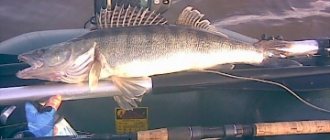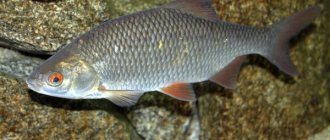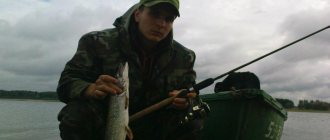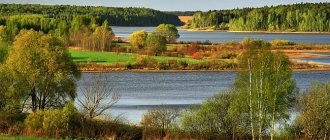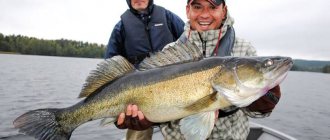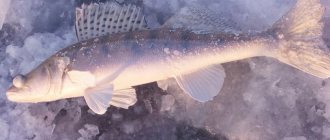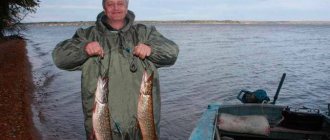Home → Blogs → 09.27.2015 // Mysteries of the Veselovsky Reservoir.
As Eastern wisdom says, you cannot enter the same river twice, and there are no two identical fishing trips, especially on the Veselovsky Reservoir.
I’ve been here twenty times, and every time it’s all over again. The fishing was successful, sometimes purely for pike, sometimes by picking up the key, we caught perch like from a machine gun, sometimes the pike perch committed atrocities. I also got to play tug-of-war with a catfish. And when the wind was raging, I got to be content with a chub in the adjacent canal. The reservoir is huge. It’s not difficult to catch a fish, but finding it and understanding it is a completely different matter.
Knowing my weakness for catching trophy perch, I received an offer to go fishing in Veselovsky from my Taganrogzh friend, an avid fisherman to the core Artyom. This season, in the month of May, I already had to visit these parts, performing at the Championship of the Stavropol Territory as part of the Novocherkassk Teams ,,Sport-Fishing. We performed rather mediocre. But even then I was amazed by the size of the perches that some lucky ones brought to the final weighing.
Like perches, they made an indelible impression on me, and it is clear that Artyom’s offer to hunt specifically for cavity monsters was tempting and desirable for me.
We set out at night. By the time we got to the place, by the time we were puffed up, by the time we had uncovered ourselves, the sun was already high. Yes, we were in no particular hurry, we did everything clearly and confidently, because there was at least 10 hours of fishing ahead.
Having previously discussed our actions, we set out in search of striped armadillos.
The wind is 4 meters per second, the waves are decent. But a good watercraft made it possible to move comfortably around the water area. They decided to look for fish on dumps, at the exit of ravines and near islands. In deep water, even with an echo sounder, this is problematic, since the lion’s share of the reservoir’s topography is an absolutely flat surface, without any anomalies. The predator has no special connection to the area. As a rule, carnivores accompany, like shepherds, constantly migrating flocks of leucorrhoea.
The very first set brought us several desired bites, but our trophies, instead of the expected monster perch, were rather weighty Manych crucian carp, which coveted the specific presentation of imitations of aquatic insects.
After catching four crucian carp, and many baits torn from the hook, we changed the place and swam to an area abounding in aquatic vegetation that had already fallen to the bottom. We found a perch. The bite was active in the morning, as expected. Lures in the form of vibrotails and dark-colored twisters worked superbly above the grass.
The size of the perch was standard from 300 to 500 grams.
The water had not yet cooled down, and the fish showed its lively temperament while playing.
When an actively feeding perch was knocked out of a point, it was necessary to use cunning techniques in order to continue fishing without changing the point. Silicone crustaceans, worms and other imitations of aquatic inhabitants, from time to time provoked the fish to bite, which still remained at the point, but did not show much activity Lures equipped with offset hooks on a light 5-gram jig had to be pulled through the grass. There was no other way to catch fish.
Artyom was on a roll. Having dug up some ridiculous (in my opinion) lure imitation of kazara in his arsenal, and even in an acid color, he caught perches one by one. Trying to find something alternative, I was clearly lagging behind.
By noon, the bites became noticeably less frequent. Probably, the perch had happily feasted near the shore and disappeared into the vast expanses of the reservoir. Without further ado, Artyom and I set off in search of it.
Having sailed a couple of kilometers across the water area of Veselki, we noticed a slight difference in depth on the echo sounder sensor. The underwater anomaly was also visible visually. The ripples on the surface of the water in this place were different and stood out against the background of the general excitement. We dropped anchor. We decided to probe this place jig. On one of the retrieves, Tyoma had a powerful bite, on Bugsy 3.5 inches. Rybina bent his light spinning rod into a donut. I exhausted my tackle and laid out the landing net. The resistance was powerful. The invisible opponent did not want to appear on the surface, he pressed to the bottom, from time to time pulling meters of line from the reel with jerks. It took a long time to tire the fish. Now the connection of the line with fluorocarbon appeared out of the water First, a breaker appeared on the water, then a huge, handsome striped perch came to the surface from the depths and fell on its side. A deft movement of the landing net and he was in the boat. We rejoice. Artyom and I shook hands. The minimum program was completed.
Magnificent, strong, beautiful fish. They smoked in silence. Individuals of this size stay apart, alone, or in schools of 2-3 fish. But fishing the place gave us only a large zander to catch up with. Which coveted the “Green beast,” - that’s how we jokingly nicknamed the imitation barracks, which Artyom taught today.
The sun was setting. You need to swim to the launch site before dark. Otherwise, without a navigator, you can simply get lost in the intricacies of ravines, channels and islands. It didn’t take long to decide to check the place where they had been fishing in the morning. The fish immediately began to respond, but the bite was no match for the morning one, and the specimens were smaller. As we passed the perch, I went out to the grass to feed and zander. We managed to catch a few pieces.
It's time to return to base. There were several more fishing boats at the slip site.
We met and talked. Not everyone was caught properly. Not many managed to pick up the key to the cunning Manych humpback whale.
Well, let my crazy perch swim and grow. Our paths will cross again.)))
Veselovskoye Reservoir
The Veselovskoe reservoir or Lake Manych stretches in a northwestern direction, crossing the Rostov region from the Salsky steppes to Kalmykia. Formed on the eve of the Patriotic War on the Western Manych River, it was designed to irrigate agricultural lands of the arid steppe region, develop fisheries, serve as a water transport artery and work for the benefit of energy.
Initially, it was planned to use a man-made route between the Don and Volga through the Manych valley, but the 300-kilometer section from Lake Manych-Gudilo to the Don River turned out to be not deep enough for navigation. It was necessary to transfer the waters of the Don and Kuban into the Western Manych River, but great depths could not be reached everywhere, and interest was lost in further work to transform the reservoir into a transport artery. But the reservoir coped with its fishing and irrigation role remarkably well. Before the Kuban was replenished with water, the reservoir had salt water, but donor waters gradually, since 1948, turned it into a freshwater reservoir.
The reservoir occupies 238 km 2 and stretches for one hundred kilometers from the Veselovsky to the Proletarsky hydroelectric complex. Its average width is about three, and its maximum is seven kilometers. It occupies a position between the Ust-Manych and Proletarsky reservoirs and has a controlled flow, allowing the water level to vary by almost ten meters. Its depth on average is slightly more than four meters, while in the lowlands it reaches nine meters, and in areas with an elevated bottom it can barely reach a meter. In summer the water heats up to 27 degrees.
The shores of the lake are strongly indented, their bends form numerous estuaries and straits. There are several large islands scattered across the water area, up to 100 hectares on which crops are grown, and about two dozen small ones. In the coastal zone, the soil is clayey with sandy areas in the east of the reservoir. The reservoir freezes from the end of November and remains under ice until mid-March.
On the reservoir you can constantly feel the turbulence of the water, and the impacts of the waves wash away the shores, making them steep, except for areas of ravines and bays. The coast was strengthened by planting bushes of trees, so the adjacent steppe areas were landscaped with forest belts. Further from the coast, rice is grown in marshy areas, and livestock is grazed in dry areas. The wetland system serves as a resting place for migratory birds and home to their waterfowl and semi-aquatic relatives: swans, storks, waders, gulls and geese. The water's edge is overgrown with cattails and reeds in places. On the banks of the reservoir there are two forests of artificial origin: “Dubrava” and “Dubki”, with a total area of 1400 hectares.
The diversity of fauna and the presence of a decent M4 highway in the area of the reservoir make it a place of pilgrimage for hunters and fishermen, of whom about forty thousand come here every year. About thirty species of fish live in the waters of the Veselovsky Reservoir. Commercial species include: pike, pike perch, bream, ram and carp. Among the rare and protected species that live here are: Koktebel katran, salvinia, and vallisneria. In the catches you can often find sabrefish, carp, asp, catfish, sterlet, silver carp, silver carp and grass carp.
The Veselovskoye Reservoir is of interest not only to fishermen and hunters. Here you can go scuba diving and search for flooded historical monuments and villages, go horseback riding, exploring the mixed salt, fresh and even nomadic lakes and rivers flowing in different directions scattered in the surrounding area. But with water tourism in the Rostov region, things are almost no different: water cruises in the region are held only in September, when navigation ends in some Russian regions.
In the village of Vesely, tourists can visit the mass grave of soldiers who died here in 1942. There are similar memorial places here in every village. Among the attractions of the Aksai region, Mukhina Balka is famous, occupying more than forty hectares. On its protected territory grow unique trees, shrubs and herbs listed in the Red Book, brought from different countries in the century before last.
The surroundings of the reservoir are abundantly populated by ticks, so fishermen and tourists better stock up on accicides for clothing and body products that repel ticks.
There are plenty of places to set up a tent camp on the banks of the Veselovskoye Reservoir, but the situation with firewood is completely different - a few trees and shrubs are unlikely to pass as fuel for a fire. Therefore, when going here on vacation, it makes sense to take firewood with you or at least a gas burner.
Tourist infrastructure is developed mainly in the area of the village of Vesely. Active recreation on the water is organized by employees of several recreation centers, among which Vesyly Manych and Cool Place are very popular.
Veselovskoye Reservoir
The last trips to the Don were unsuccessful, I decided to go to the reservoir, the place is definitely a fishing place, but my relationship with it did not work out very well, on high water in the wind it is not comfortable and even dangerous, and the winds are frequent. Fishing on the reservoir of two types of shallows: channels, beams, baits, windows between the grass of which there is a lot, under the reeds, spots of shells in the catch of perch, grass pike and in deep water where the bottom is as flat as a table, 98% + small irregularities: navels, holes, you need to look for fish: pike perch, pike, catfish, all trophies in deep water, without a motor and a planing kit there is nothing to do there, of course you can, but this significantly reduces the chances of catching.
